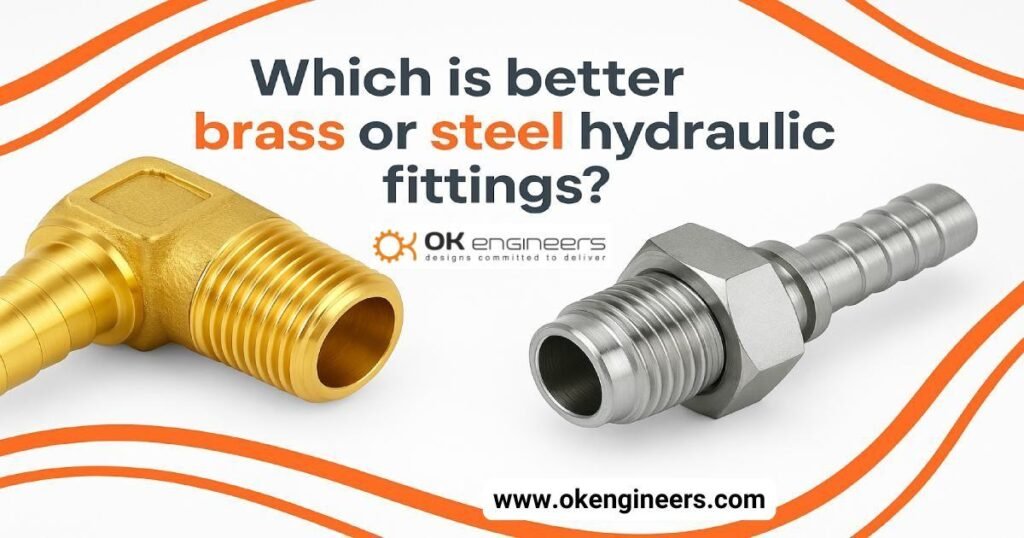The best choice between brass and steel Hydraulic Fittings depends on your system’s requirements—especially pressure, corrosion resistance, environment, and budget. Brass fittings excel in moderate-pressure, highly corrosive, or cost-sensitive applications, while steel (especially stainless steel) fittings are superior for high-pressure, extreme environments, and long-term durability.
Table of Contents
- Direct Comparison: Brass vs Steel Hydraulic Fittings
- Key Features and Benefits
- Application Suitability
- Cost, Maintenance, and Longevity
- Brass vs Steel: Quick Comparison Table
- Practical Checklist for Choosing Fittings
- Call to Action
- Frequently Asked Questions (FAQ)
Direct Comparison: Brass vs Steel Hydraulic Fittings
Brass hydraulic fittings are ideal for:
- Moderate-pressure systems (up to 3,000 psi)
- Environments with high corrosion risk (water, chemicals)
- Applications requiring ease of installation and good machinability
- Projects with tighter budgets
Steel hydraulic fittings (especially stainless steel) are best for:
- High-pressure systems (10,000 psi and above)
- Harsh, abrasive, or saltwater environments
- Applications demanding maximum strength, durability, and longevity
- Minimal maintenance and long service life
Key Features and Benefits: Brass vs Steel Hydraulic Fittings
Brass Hydraulic Fittings
- Corrosion Resistance: Excellent against water, chemicals, and many corrosive environments
- Malleability: Easy to machine, shape, and install—ideal for custom or compact fittings
- Temperature Handling: Withstands up to 400°F
- Pressure Rating: Moderate (typically up to 3,000 psi)
- Cost: Generally less expensive than stainless steel
- Weldability: Easier to weld than stainless steel
- Machinability: Superior for small, precise components
- Conductivity: High thermal and electrical conductivity
Steel (Stainless) Hydraulic Fittings
- Strength: Much higher tensile strength (515–620 MPa vs. brass’s 338–469 MPa)
- Pressure Handling: Suitable for very high-pressure systems (10,000 psi or more)
- Corrosion Resistance: Exceptional, especially in saltwater or highly acidic environments
- Durability: Lifespan often exceeds 50 years with minimal maintenance
- Maintenance: Requires little to no coating or upkeep
- Temperature Handling: Withstands up to 1,000°F (316 stainless steel)
Application Suitability
| Application Type | Brass Fittings | Steel (Stainless) Fittings |
| Water & HVAC Systems | Excellent | Excellent |
| Oil & Gas Industry | Good (moderate PSI) | Best (high PSI, harsh fluids) |
| Marine/Offshore | Good | Best (saltwater resistance) |
| Power Plants | Good | Best |
| Chemical Processing | Excellent | Excellent |
| High-Pressure Hydraulics | Limited | Best |
Cost, Maintenance, and Longevity
- Brass: Lower upfront cost, easier to machine and install, but may require more frequent replacement in high-stress environments.
- Steel: Higher initial investment, but lower total cost of ownership due to longer lifespan and less maintenance.
Brass vs Steel: Quick Comparison Table
| Feature | Brass Fittings | Steel (Stainless) Fittings |
| Max Pressure | ~3,000 psi | 10,000–20,000+ psi |
| Corrosion Resistance | Excellent (most cases) | Superior (saltwater/acid) |
| Malleability | High | Moderate |
| Machinability | Excellent | Moderate |
| Cost | Lower | Higher |
| Lifespan | Good | Excellent (50+ years) |
| Maintenance | Moderate | Minimal |
Practical Checklist: How to Choose Between Brass and Steel Hydraulic Fittings
- Assess System Pressure:
- Up to 3,000 psi: Brass is suitable
- Above 3,000 psi: Choose steel or stainless steel
- Evaluate Corrosive Exposure:
- Water, chemicals: Brass is excellent
- Saltwater, acids: Stainless steel is superior
- Consider Budget Constraints:
- Tight budget: Brass
- Long-term investment: Steel
- Check Installation Requirements:
- Need for custom shapes or easy machining: Brass
- Standardized, high-strength parts: Steel
- Plan for Maintenance & Longevity:
- Low maintenance, long life: Steel
- Acceptable periodic replacement: Brass
Author Credentials
Written by an experienced mechanical engineer and hydraulic systems specialist with over 15 years of experience in industrial fluid power solutions. All technical data cited from recent industry publications and manufacturer guidelines (2024–2025).
Actionable Summary
- For moderate-pressure, cost-sensitive, or highly corrosive (but not saltwater) environments, Brass hydraulic fittings are an excellent choice.
- For high-pressure, saltwater, or critical safety applications, steel (especially stainless steel) hydraulic fittings provide unmatched strength and durability.
Ready to upgrade your hydraulic system or need expert advice on the right fittings? Contact the team at Ok Engineers for a personalized consultation or browse our full range of hydraulic solutions.
Have more questions? Leave a comment below or request a quote—our experts are here to help you make the best choice for your application!
FAQ
Q1: Are brass fittings safe for high-pressure hydraulic systems?
Brass is generally suitable for moderate-pressure systems (up to 3,000 psi). For high-pressure or critical safety applications, steel or stainless steel is recommended.
Q2: Which fitting is better for marine or saltwater environments?
Stainless steel outperforms brass in saltwater and highly corrosive environments due to its superior resistance to pitting and corrosion.
Q3: Is brass easier to install than steel?
Yes. Brass is more malleable and machinable, making it easier to install, especially in tight or custom applications.
Q4: What about cost differences?
Brass fittings are typically less expensive than stainless steel, making them attractive for budget-conscious projects where extreme durability is not required.
Q5: Can brass and steel fittings be mixed in the same system?
Mixing materials can lead to galvanic corrosion, especially in the presence of moisture. It’s best to use the same material throughout a hydraulic system unless a specific engineering reason dictates otherwise.



